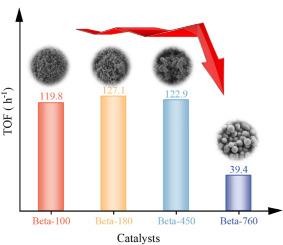粒径对2,5-二甲基呋喃和丙烯酸Diels-Alder转化为对二甲苯的影响
IF 4.7
3区 材料科学
Q1 CHEMISTRY, APPLIED
引用次数: 0
摘要
2,5-二甲基呋喃(DMF)在β沸石上经Diels-Alder (D-A)环加成制备对二甲苯(PX)的工艺被认为是一种绿色、可持续的PX生产途径。理论上,需要合成小的沸石颗粒来减轻其固有的微孔结构造成的传质限制,但颗粒大小的改变同时会改变结晶度、酸度和孔隙特征。这些因素对Diels-Alder (D-A)环加成反应的影响尚未完全阐明。本研究制备了平均粒径为100 nm、180 nm、450 nm和760 nm的β沸石,并将其应用于DMF反应的D-A环加成。所有β沸石均表现为由纳米晶组成的多晶结构,并具有微孔和介孔。在160℃下,粒径为760 nm的β沸石的翻转频率(TOF)约为其他三种沸石的三分之一,其生成PX的表观活化能(Ea)明显低于粒径较小的沸石。活性和Ea的降低主要归因于大颗粒沸石的明显传质限制,这种限制主要源于扩散路径延长、介孔减少、结构失配和内部晶界的微孔排列。在消除传质限制的粒径范围内,过小的粒径也会对催化性能产生不利影响,因为在反应过程中更容易结晶度降低。本文章由计算机程序翻译,如有差异,请以英文原文为准。

Effects of Beta particle size on Diels–Alder conversion of 2,5-dimethylfuran and acrylic acid to para-xylene
The process of producing para-xylene (PX) from 2,5-dimethylfuran (DMF) via Diels-Alder (D-A) cycloaddition over Beta zeolites was recognized as a green and sustainable pathway for PX production. Theoretically, small zeolite particles need to be synthesized to mitigate mass transfer limitations caused by their inherent microporous structure, but particle size changes simultaneously alter crystallinity, acidity, and pore characteristics. The effects of these factors on the Diels-Alder (D-A) cycloaddition reaction have not yet been fully elucidated. In this study, Beta zeolites with average particle sizes of 100 nm, 180 nm, 450 nm, and 760 nm were prepared and applied to the D-A cycloaddition of DMF reaction. All Beta zeolites exhibited a polycrystalline structure composed of nanocrystallites and featured both micropores and mesopores. The turnover frequency (TOF) of Beta zeolite with 760 nm particle size was approximately one-third that of the other three zeolites at 160 °C, and its apparent activation energy (Ea) for PX formation was significantly lower than that of the smaller-particle zeolites. The reduced activity and Ea were primarily attributed to significant mass transfer limitation in larger-particle zeolites, with this limitation mainly originating from lengthened diffusion paths, diminished mesoporosity, mismatch in structure, and micropore alignment by internal grain boundaries. Within the particle size range where mass transfer limitations were eliminated, excessively small particle size can also detrimentally impact catalytic performance, owing to easier crystallinity reduction during the reaction.
求助全文
通过发布文献求助,成功后即可免费获取论文全文。
去求助
来源期刊

Microporous and Mesoporous Materials
化学-材料科学:综合
CiteScore
10.70
自引率
5.80%
发文量
649
审稿时长
26 days
期刊介绍:
Microporous and Mesoporous Materials covers novel and significant aspects of porous solids classified as either microporous (pore size up to 2 nm) or mesoporous (pore size 2 to 50 nm). The porosity should have a specific impact on the material properties or application. Typical examples are zeolites and zeolite-like materials, pillared materials, clathrasils and clathrates, carbon molecular sieves, ordered mesoporous materials, organic/inorganic porous hybrid materials, or porous metal oxides. Both natural and synthetic porous materials are within the scope of the journal.
Topics which are particularly of interest include:
All aspects of natural microporous and mesoporous solids
The synthesis of crystalline or amorphous porous materials
The physico-chemical characterization of microporous and mesoporous solids, especially spectroscopic and microscopic
The modification of microporous and mesoporous solids, for example by ion exchange or solid-state reactions
All topics related to diffusion of mobile species in the pores of microporous and mesoporous materials
Adsorption (and other separation techniques) using microporous or mesoporous adsorbents
Catalysis by microporous and mesoporous materials
Host/guest interactions
Theoretical chemistry and modelling of host/guest interactions
All topics related to the application of microporous and mesoporous materials in industrial catalysis, separation technology, environmental protection, electrochemistry, membranes, sensors, optical devices, etc.
 求助内容:
求助内容: 应助结果提醒方式:
应助结果提醒方式:


